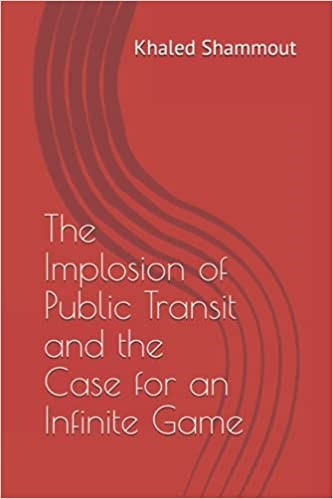
The Implosion of Public Transit and the Case for an Infinite Game – Khaled Shammount
“The Implosion of Public Transit and the Case for an Infinite Game” is a book that explores the idea to implement the infinite game theory in the public transit sector. The book is written by Mr. Khaled Shammount (Linkedin) who has over 26 years of transit experience in both the public and private sectors. You can buy book online.
Some of the key quotes from the book:
1. Public transit agencies have been running annual deficits for several years and thus have been forced to reduce the level of service they produce, making bad situations even worse.
2. The increase in service and lack of meaningful change in ridership have negatively impacted the productivity of bus transit over the past 20 years, as it dropped from 35 unlinked passenger trips per revenue hour to a mere 27.3 (a 20% drop).
3. Operating expense per unlinked passenger has doubled to $5.24 over the past 20 years.
4. Once a plateau is reached, it only goes downhill from here.
5. Transit is a $50 billion industry employing close to half a million people translating to about $20 billion in annual salaries and another $30 billion (annually) in buses, parts, utilities, construction and consulting services.
6. The demise of transit will be from within and not because of any outside agent.
7. The solution for transit is to abandon traditional transit service and become a local mobility manager providing mobility by subscription and utilizing driverless cars.
8. Playing an infinite game requires that transit agencies move beyond known boundaries, create their own set of tools and rules, and most importantly remain one or more steps ahead of their competition.
9. Transit agencies should develop a strategic plan focusing on five primary things:
-
- Describe the status quo of the agency and its service
- Identify the needs of staff and agency
- Identify solutions and remedies to overcome challenges
- Include a detailed roadmap to implement the identified solutions
- Establish Key Performance Indicators (KPIs)
10. Once the strategic plan is in place, transit agencies should work on an Implementation plan (roadmap)
-
- Description of the need
- Description of the proposed solution
- Expected benefits of this solution
- Individual responsible for its implementation
- Associated cost of implementation
- Detailed schedule of implementation
- Key Performance Indicators (KPIs)
11. Too many agencies prioritize solutions based on what they (believe they) can afford. In reality, it should be based on what is a system requirement.
12. In 2000, the Federal Transit Administration’s Assistance to transit agencies constituted about 25% of transit agencies operating costs. This share has been declining ever since reaching a low 7.1% in 2019.
13. Transit agencies should tell their employees that they are in business not to provide transportation but to influence people’s lives and improve the way they live their lives. Employees’ work and effort have an impact on everybody within a service area, not just transit riders.
14. “If the rate of change on the outside is greater than the rate of change on the inside, the end is near” ~Jack Welch, Former CEO of General Electric
15. “Everything is related to everything else, but near things are more related than distant things” ~Waldo Tobler’s first law of geography
16. Transit agencies should use spatial analysis. There are alternative correlation techniques designed for spatial analysis such as Joint Count, Moran’s I and Geary’s C, among others.
17. Hedonic regression is a revealed preference method used to measure the demand for a good based on its value to the customer.
18. Riding transit is not driven by socioeconomic/demographic characteristics but more by whether it meets the individual’s preference.
19. Transit agencies should use new tools like:
-
- Data Envelpoment Analysis (DEA)
- Advanced GIS Analysis (Heat maps, Kernel and Point Density maps, Thiesen or Voronoi polygans)
- Spatial Optimization Modeling (Point-based location / Line-based location / Area-and-Coverage based location / Location allocation)
- Planning software
- Process improvement software (Arena)
20. Crappy People theory – An A-grade manager will hire an A-grade employee, and a B-grade manager will hire a C-grade employee ~Marc Andressen
21. It is best to focus on hiring individuals who already have customer service skills – convenience store cashiers, fast food workers, grocery store employees. These generally have good customer service skills and they can acquire their CDL in no time.
22. Transit agencies should follow Systems Engineering Approach to ensure successful implementation. FTA requires agencies to use it when implementing ITS technologies using grants.
23. Trusting teams – the highest level of harmony among employees and the highest collaboration levels in work ~Simon Sinek
24. The successfulness of a transit system is the percentage of choice riders.


